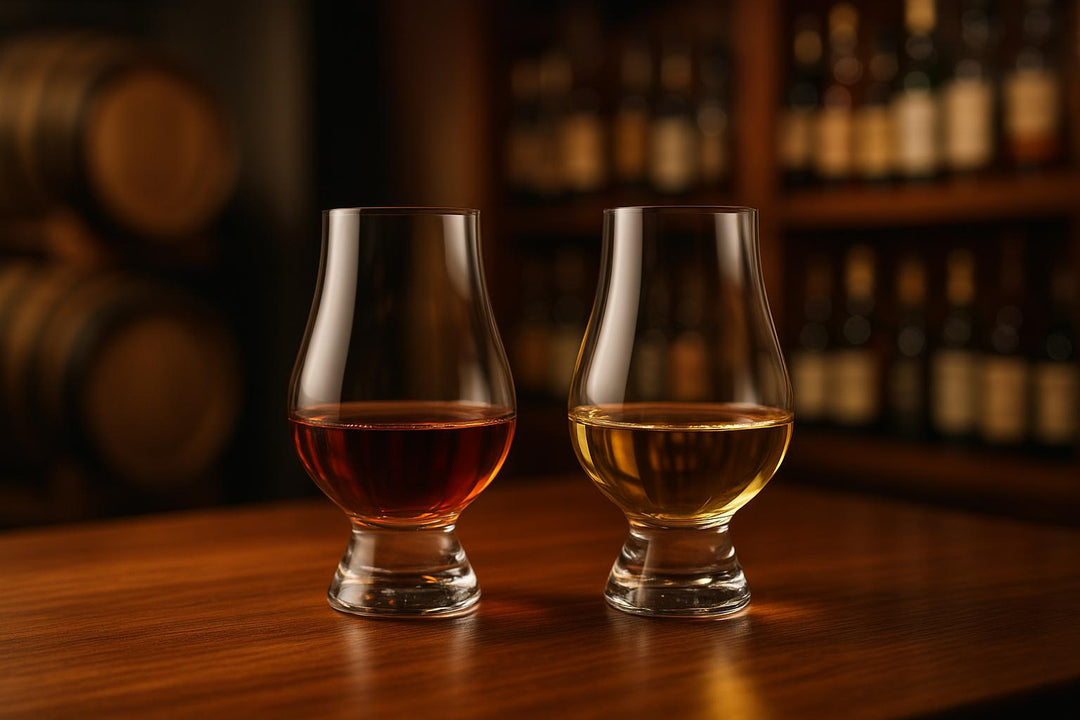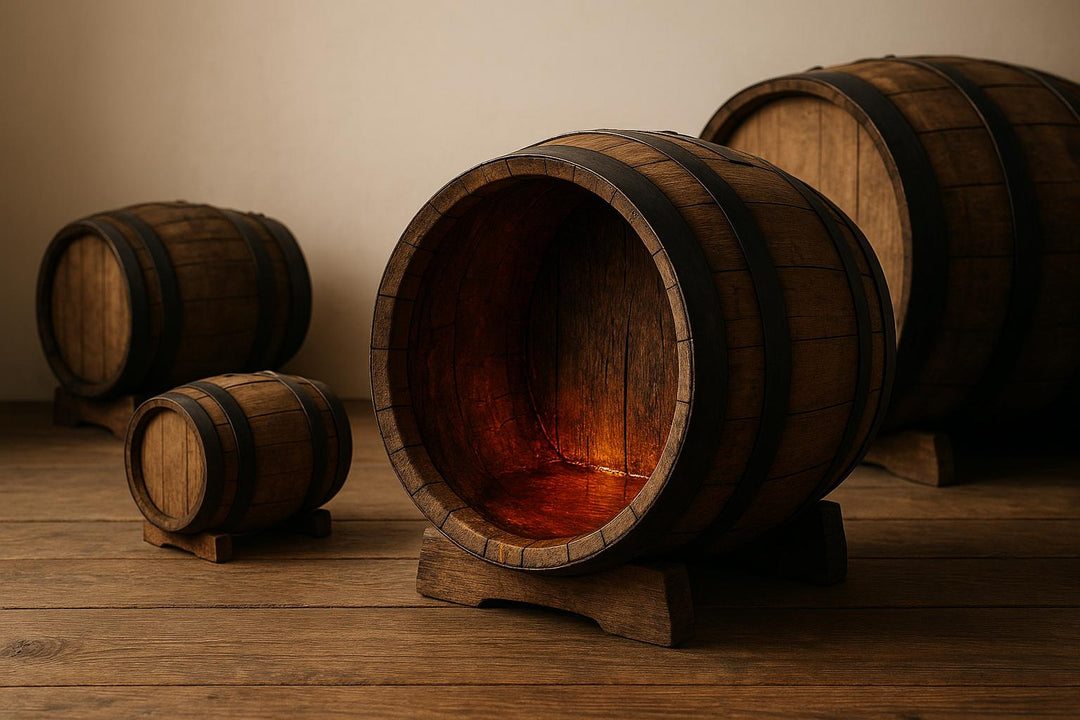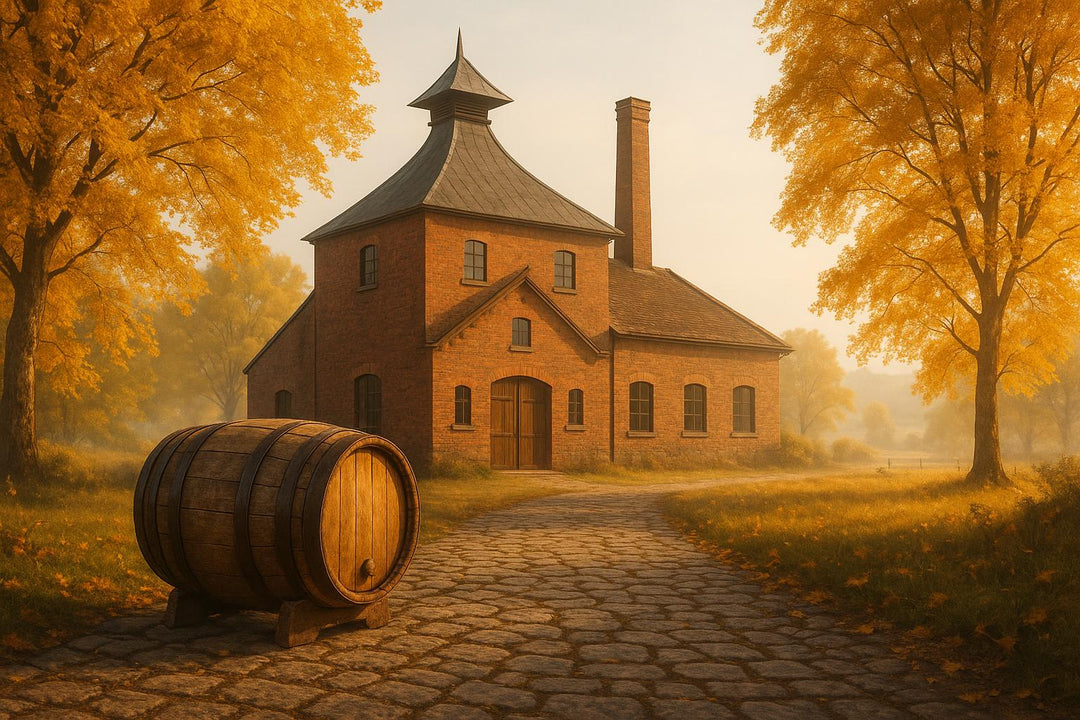Whisky maturation transforms raw spirit into a complex drink, with traditional methods relying on years in oak casks to develop flavour. Accelerated ageing, using techniques like heat, pressure, and smaller barrels, aims to replicate this process in months or even days. Here's what you need to know:
- Traditional maturation: Takes 3–25+ years, creates nuanced flavours through natural chemical changes, but is costly and time-intensive.
- Accelerated ageing: Uses modern methods to speed up maturation (e.g., ultrasonic waves, heat cycling), reducing costs and time, but often lacks the depth of traditional whisky.
Key takeaway: Traditional methods remain the benchmark for complexity, while accelerated techniques offer faster, more affordable alternatives. Both approaches cater to different market needs, but the ultimate test is whether the whisky satisfies your palate.
Standard Whisky Maturation: Time-Tested Methods
When it comes to crafting whisky, traditional maturation methods remain the benchmark for producing spirits with depth and character. This age-old process hinges on the delicate interplay between the spirit, the wood of the cask, and the passage of time. While it can take years - or even decades - the results are evident in every sip of a well-aged dram.
How Cask Aging Works
At the heart of traditional whisky maturation is the oak cask, carefully chosen and prepared to shape the spirit's flavour. In Scotland, about 95% of whisky rests in American white oak barrels, known for imparting sweet vanilla and coconut notes. European oak, on the other hand, adds spicier, richer flavours, lending a distinctive complexity to the whisky.
The length of time a whisky spends in the cask is critical. While regulations set minimum ageing requirements, premium whiskies often mature far longer, allowing for a more refined flavour profile.
Cask size also influences the maturation process. Smaller casks, with their larger surface area relative to volume, speed up flavour extraction. Some distilleries use this to their advantage, starting with smaller barrels for intense flavour development before moving the spirit to larger casks for slower, more subtle refinement.
The cask's previous contents play a huge role in the whisky's final taste. Ex-sherry casks bring notes of sweetness, vanilla, and caramel, while ex-bourbon casks contribute hints of dried fruit and toffee. First-fill casks, which are used for the first time after holding another spirit, impart stronger flavours compared to refill casks, giving distillers precise control over the whisky's evolution.
These factors set the stage for the fascinating chemical transformations that occur during the ageing process.
Chemical Changes During Aging
Whisky maturation is a complex journey of transformation, driven by three key processes: additive, subtractive, and interactive changes. Remarkably, these changes are responsible for 60–80% of the final flavour in Scotch Malt Whisky.
Additive maturation involves the wood transferring its own flavours to the spirit. Oak releases compounds such as vanillin, which gives whisky its vanilla notes, and tannins, which add structure and depth. Depending on the type of oak and its previous use, the cask may also introduce caramel, spice, or fruity characteristics.
Subtractive maturation is the process by which undesirable elements in the raw spirit are removed. The wood acts like a natural filter, absorbing sulphur compounds and other harsh elements, resulting in a smoother, more refined whisky.
Interactive maturation refers to the chemical reactions that occur within the spirit over time. Oxidation, as oxygen seeps through the cask's porous wood, plays a key role in developing richer, more layered flavours. Esterification - a reaction between acids and alcohols - creates fruity and floral notes, while countless other compounds break down and recombine, adding layers of complexity.
Temperature fluctuations also play a part. As the spirit expands and contracts with seasonal changes, it moves in and out of the wood, drawing out essential compounds. This natural "breathing" is a slow process that cannot be rushed, making patience a critical virtue in whisky production.
How Climate Affects Maturation
Beyond the cask and its chemistry, the environment where the whisky is stored significantly impacts its maturation. Warmer climates, like those in Japan, Australia, or Taiwan, accelerate the interaction between the spirit and the wood, allowing these whiskies to mature more quickly than their Scottish counterparts. These conditions often lead to bold, intense flavours in a shorter period.
Climate also affects evaporation, known as the "angel's share." In warmer, drier regions, this evaporation happens faster, concentrating the remaining liquid and intensifying its flavours.
The design of the warehouse and storage methods also shape the whisky's character. Traditional dunnage warehouses, with their thick stone walls and earthen floors, provide stable conditions for slow, steady maturation. This method is prized for creating subtle, layered flavours over decades.
In contrast, racked warehouses expose barrels to more varied conditions. Casks stored higher up experience warmer temperatures and mature faster, while those lower down age more slowly. This variability allows distillers to blend whiskies with a range of characteristics, even from the same warehouse.
Modern palletised warehouses offer precise climate control, but some argue this approach sacrifices the natural variation that contributes to a whisky's complexity. Each distillery chooses its storage method based on its philosophy of balancing consistency with flavour development.
Seasonal changes also play a vital role. Summer heat pushes the spirit deeper into the wood, extracting more flavour, while cooler winter temperatures allow these flavours to integrate and mellow. This annual rhythm, repeated over many years, is what gives traditionally matured whisky its signature depth and complexity.
Regional differences further enhance whisky's unique character. For example, Scotch whiskies from the Highlands develop differently from those in Speyside, while Islay whiskies boast a maritime influence that imbues them with a distinctive profile. These regional traits celebrate the essence of whisky-making - a process deeply tied to its environment and impossible to replicate artificially.
Accelerated Whisky Aging: Modern Techniques
Modern whisky-making is taking a bold step forward by compressing decades of aging into mere months. Distillers are now using advanced methods to speed up the maturation process, mimicking or enhancing the natural chemical changes that typically unfold over years. While traditionalists may view these techniques with scepticism, the approach is gaining ground among both craft producers and established brands eager to meet growing demand faster.
Main Accelerated Aging Methods
One of the simplest ways to accelerate whisky aging is small barrel aging. By swapping the traditional 200-litre casks for smaller barrels holding just 5 to 20 litres, distillers increase the whisky’s contact with the wood. This higher wood-to-whisky ratio speeds up flavour extraction and oxidation, allowing the spirit to gain characteristics of years-long aging in just 12 to 24 months.
Heat cycling is another popular method. By heating and cooling barrels in controlled conditions, distillers cause the whisky to expand and contract, pushing it deeper into the wood. This process intensifies the interaction between the spirit and the oak, achieving results equivalent to four years of traditional aging in as little as 6 to 12 months.
With pressure aging, distillers take a more aggressive route by applying pressure to drive the whisky into the wood. This technique accelerates the absorption of flavour and colour compounds, cutting aging times by 50–70% compared to conventional methods.
Then there’s ultrasonic aging, which uses sound waves to create high- and low-pressure zones within the barrel. This cavitation effect enhances the whisky’s contact with the wood, speeding up flavour development. Some producers claim it can replicate three years of traditional aging in under three months.
Finally, wood alternatives and barrel inserts offer a creative way to shorten maturation. By adding wood chips, staves, or inserts directly into the aging vessel, distillers increase the surface area for interaction, speeding up flavour extraction. Some even experiment with woods like maple, hickory, or cherry to craft unique profiles. Others use wooden slats inside barrels, blending modern efficiency with traditional techniques.
The Science Behind Faster Aging
These methods all revolve around manipulating key factors of traditional whisky maturation: surface area, temperature, pressure, and agitation. By intensifying the whisky’s interaction with wood, they accelerate the release of flavour compounds and boost chemical reactions like oxidation and esterification.
For example, small barrels or wood additives expose the whisky to more surface area, while heat cycling and pressure aging force the spirit deeper into the wood. Techniques like ultrasonic aging add agitation to the mix, speeding up the process even further. However, replicating the intricate balance of reactions that occur during years of traditional aging remains a significant challenge for these approaches.
Real Examples of Accelerated Aging
These techniques aren’t just theoretical - distilleries around the world are already putting them into practice, with impressive results.
In Ohio, Cleveland Whiskey has developed a pressure-aging method that condenses years of maturation into just 24 hours. Using stainless steel tanks and carefully calibrated cycles, they force whisky through wood. As Tom Lix, CEO of Cleveland Whiskey, explains:
"Think about a sponge [underwater], when you squeeze it. When you let it go, water rushes in. That's essentially what we do, but we take young spirits and put them in stainless tanks with a measured amount of wood."
Over in Los Angeles, Lost Spirits Distillery has created THEA One, a patented reactor that combines heat, light, and wood chemistry to produce whiskies with remarkable depth in a fraction of the usual time.
At Copper Fox Distillery in Virginia, charred wood chips - including fruit woods like apple and peach - are steeped directly in barrels. This method creates rich, complex flavours in just 18 months. Rick Wasmund, the distillery’s owner, says:
"It's just a rich and complex new set of ingredients on your taste buds."
In Texas, Balcones Distillery takes advantage of the state’s hot climate, pairing small barrels with shorter aging periods at higher temperatures. Their Texas Single Malt Whisky proves that quality doesn’t always require long maturation.
Meanwhile, Tuthilltown Spirits in New York has experimented with tiny casks ranging from 3 to 10 gallons. Their findings show that smaller barrels enhance certain flavours, like vanilla, which aren’t as pronounced in larger casks.
These examples highlight how accelerated aging is already transforming whisky production. Yet, the debate continues: can these methods truly match the depth and complexity of traditional, time-honoured aging?
Standard vs Accelerated Aging: Direct Comparison
Now that we've examined both traditional and modern whisky maturation methods, let's see how they stack up. These approaches differ in more than just the time they take - they influence everything from flavour depth to production costs and even consumer perception. By comparing them side by side, we can better understand how each shapes the whisky-making process.
Comparison Table: Standard vs Accelerated Aging
Here's a breakdown of the main differences between traditional and accelerated ageing methods:
| Factor | Traditional Maturation | Accelerated Aging |
|---|---|---|
| Time Required | 3-25+ years | 3 months to 2 years |
| Flavour Complexity | Rich, layered, and nuanced | Often simpler, lacking subtlety |
| Chemical Development | Natural processes like oxidation and esterification | Forced extraction, limited compound evolution |
| Cost Efficiency | High storage costs, capital tied up | Lower costs, quicker turnover |
| Environmental Impact | 2% annual liquid loss through evaporation | Minimal loss in controlled environments |
| Market Acceptance | Well-established and trusted | Gaining traction but still faces scepticism |
| Regulatory Compliance | Meets traditional age statement rules | Often doesn’t qualify for age statements |
| Flavour Profile | Complex interplay of tastes | Noticeable but less complex oak notes |
Pros and Cons of Each Method
Both approaches come with their own strengths and challenges, shaped by technical, economic, and market factors.
Traditional maturation is renowned for its ability to develop intricate flavours. The slow ageing process allows for natural chemical reactions - like oxidation, esterification, and polymerisation - that create a symphony of tastes. The use of American white oak barrels, which dominate the whisky scene in Scotland, plays a huge role here. These barrels infuse whisky with beloved notes of vanilla and caramel, thanks to natural compounds like vanillin and lactones.
However, this process is far from cheap or efficient. Distilleries face steep storage costs and the financial strain of tying up capital for years, sometimes decades. Additionally, they must accept regular product losses due to evaporation - often referred to as the "angel's share." With bourbon prices climbing by over 9% annually, these factors make traditional ageing a costly endeavour, especially as demand continues to grow.
On the other hand, accelerated aging offers a practical solution to some of these challenges. By speeding up the maturation process, distilleries can experiment with different variables in a fraction of the time. This flexibility not only reduces storage needs but also allows for quicker returns on investment. Rick Wasmund from Copper Fox Distillery highlights the potential here:
"I think the industry invests a lot of effort in equating age with quality. But all you need to do is let people try [the spirit] blind and take it from there."
Yet, accelerated techniques come with their own set of hurdles. While they can replicate certain flavours - especially oak-forward notes - the results often lack the complexity and balance of traditionally aged whiskies. The forced extraction of compounds can produce a drinkable spirit, but it rarely achieves the multi-layered depth whisky enthusiasts expect.
Regulations also pose a challenge. Many countries enforce minimum ageing requirements for whisky classification, which accelerated methods may not meet. This creates a marketing dilemma, as producers cannot use traditional age statements that consumers associate with quality and authenticity.
Authenticity, in fact, remains a key concern for many whisky lovers. As Julia Ritz Toffoli, founder of Women Who Whiskey, puts it:
"I think that, ultimately, there's no true substitute for time."
Her view reflects a broader tension in the industry: balancing innovation with the deep-rooted traditions that define whisky-making. While accelerated methods address practical production concerns, they must overcome decades of consumer education that equates age with quality.
Ultimately, both methods have their place in the modern whisky world. Traditional maturation continues to set the bar for premium spirits, while accelerated techniques provide room for experimentation and help meet rising demand. The challenge lies in knowing which method aligns best with the distiller’s goals - and satisfies the drinker’s palate.
sbb-itb-128d6c1
Effects on Whisky Enthusiasts and the UK Market
The ongoing debate between accelerated ageing and traditional maturation isn’t just a technical matter for distilleries - it’s reshaping how UK whisky enthusiasts view and value their favourite spirit. Beyond the production process, it’s influencing collectors’ attitudes, market trends, and spending habits, creating a ripple effect within the whisky world.
How Views on Value and Authenticity Are Changing
A 2010 survey highlighted how deeply age statements were ingrained in whisky culture: 94% of respondents associated age statements with quality, 93% believed older whiskies were superior, and 89% actively sought them out when making purchases. These numbers reflect a long-standing belief that age equals excellence.
But times are changing. The increasing popularity of No Age Statement (NAS) bottles - many made using accelerated ageing methods - has stirred up mixed reactions. Some whisky lovers are uneasy about NAS bottles, especially when they come with premium price tags. Others, however, welcome the flexibility these techniques offer, allowing distillers to push flavour boundaries without being tied to traditional ageing timelines.
Market trends also reflect this shift. In Q2 2024, auction values dropped by 50% compared to the previous year. Bottles priced under £1,000 now make up more than half of all transactions, with a 43% surge in volume. Scott Walker, Head of Valuations at Whisky.Auction, observed:
"We're still seeing interest in spirits categories at every price point from whisky lovers and collectors, but there's been a reset in prices of some bottles and brands that have been reaching very high hammer prices in the last few years."
This adjustment signals a growing emphasis on quality over age, as many younger drinkers prioritise flavour and complexity over the number on the label. The UK’s premiumisation trend, projected to grow at 6.5% CAGR from 2025 to 2033, further highlights this shift. Whisky enthusiasts are increasingly drawn to distinctive spirits with unique flavour profiles, whether they’re crafted through traditional or accelerated methods.
Transparency has also become a top priority for consumers. Distilleries employing accelerated techniques are under pressure to clearly communicate their methods, as whisky drinkers demand honesty about what’s in their glass.
Still, whisky in the UK carries a deep emotional connection to heritage and craftsmanship. For purists, any deviation from traditional methods invites scrutiny, as they see the craft as a guardian of time-honoured practices.
The Role of The Really Good Whisky Company

As whisky drinkers’ preferences evolve, brands are adapting to meet new expectations. The Really Good Whisky Company has positioned itself as a guide for UK enthusiasts, bridging the gap between tradition and innovation. Their carefully curated offerings help consumers navigate the increasingly diverse whisky market.
For collectors, the company provides access to rare and old bottles that showcase the depth and complexity only traditional maturation can achieve. Their selection spans aged Scotch, Japanese, American, and other world whiskies, appealing to those who value the legacy of time-tested methods.
At the same time, their whisky tasting packs offer a chance for curious drinkers to explore both classic and modern approaches. These curated selections allow whisky lovers to refine their palates and form their own opinions about quality, regardless of whether a bottle was matured over decades or crafted with accelerated techniques. As Ron Nadel, Pub Bartender and Certified Whisky Ambassador, puts it:
"The real answer is in your mouth."
The company’s bespoke bottling and custom label services further reflect the evolving market. By working with distilleries that use various maturation methods, they bring unique expressions to the table, challenging traditional categories while maintaining a focus on exceptional quality.
With Scotch whisky exports reaching £5.4 billion in 2024 - accounting for 22% of all UK food and drink exports - the company’s international shipping capabilities ensure that both conventional and experimental whiskies reach global markets, where attitudes toward accelerated ageing may vary.
Their London boutique also offers a rare opportunity for face-to-face interaction with knowledgeable staff. In an era dominated by digital marketing, this personal touch allows for deeper conversations about whisky quality that go beyond simple age statements.
Through their balanced approach, The Really Good Whisky Company showcases the best of both worlds: traditional craftsmanship and modern innovation. By focusing on quality above all else, they help whisky lovers navigate a landscape that’s as complex as the spirit itself.
Conclusion: Finding the Right Balance
The discussion around traditional versus accelerated whisky maturation isn’t about picking sides - it’s about appreciating the strengths each approach brings to today’s whisky world.
Traditional maturation is still revered for its ability to create depth and complexity. The slow, patient interaction between the spirit and the wood over years results in intricate flavour profiles that many believe accelerated methods simply can’t replicate. For purists, the charm of a whisky aged for decades in charred oak barrels remains unmatched.
On the other hand, accelerated techniques bring something new to the table. Methods like heat cycling can condense what would take four years of traditional ageing into just 6–12 months, while ultrasonic ageing can mimic a 3-year-old whisky in under three months. These techniques cater to modern demands for affordability, accessibility, and innovation, offering whisky enthusiasts more options without breaking the bank. They’re not just about speeding up production; they’re reshaping how we think about whisky.
Tom Lix, founder of Cleveland Whiskey, sums it up well:
"There will always be a market for traditional aged spirits that are older and unique and rare. But there is also a market for a good quality everyday product that's affordable and that matches the quality of something that costs more to make."
For whisky lovers in the UK, this evolution translates into greater variety and more opportunities to explore. Traditional whiskies deliver the heritage and complexity that collectors treasure, while accelerated options open doors to new flavours at a more accessible price point.
Take The Really Good Whisky Company, for instance. Their approach highlights this balance perfectly. Their range includes everything from rare, traditionally aged whiskies that reflect decades of craftsmanship to innovative expressions that push the boundaries of what whisky can be. Their tasting packs encourage whisky fans to explore and decide for themselves, regardless of how the whisky was made.
The future of whisky lies in blending the old with the new - honouring time-tested practices while embracing modern advancements. Whether your whisky spent decades in a Scottish warehouse or just months in a high-tech facility, the ultimate question is simple: does it delight your taste buds?
FAQs
How does the flavour complexity of traditionally matured whisky compare to whisky aged using accelerated methods?
Traditional whisky maturation is all about time and patience, creating deep, layered flavours as the spirit slowly interacts with the wood over several years. This extended process brings out subtle notes of oak, vanilla, dried fruits, and spices, crafting a whisky with a harmonious and intricate character.
On the other hand, accelerated ageing aims to speed things up but often sacrifices complexity. These methods may result in bold flavours like wood or vanilla, but they usually fall short on depth and balance. The secret of traditional maturation lies in the slow, natural chemistry that simply can't be rushed.
How do modern techniques like ultrasonic waves and pressure ageing impact whisky production and the environment?
Modern whisky production is seeing a shift with the adoption of accelerated ageing techniques like ultrasonic waves and pressure ageing, which aim to make the process more resource-efficient. By speeding up maturation, these methods reduce the need for prolonged storage, a practice that typically demands significant amounts of energy and water.
Ultrasonic waves work by intensifying chemical reactions and enhancing flavour development in a much shorter time. Meanwhile, pressure ageing replicates natural conditions such as temperature and humidity to achieve similar results. Together, these methods help lower energy consumption, conserve resources, and shrink the carbon footprint tied to traditional whisky ageing. What's more, they achieve this without sacrificing the quality that whisky lovers expect.
What regulatory challenges do distilleries face when using accelerated ageing methods for whisky?
Distilleries experimenting with accelerated ageing techniques for whisky often face regulatory hurdles due to strict legal standards. Take Scotch whisky, for instance - it must be matured for at least three years to qualify as whisky under official classifications. This makes it challenging for spirits aged through quicker methods to gain legal recognition as whisky.
In many areas, regulations are in place to protect traditional ageing methods. While these rules are intended to uphold quality and heritage, they can pose significant obstacles for distillers trying to adopt faster, more modern maturation processes.







Leave a comment